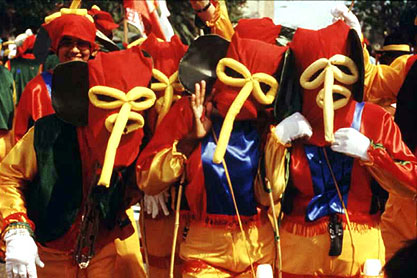I’ll be leaving for my trip to Colombia tomorrow and one of the added bonuses of my mini-vacation is that I’ll get to experience Carnival again. Its an annual festival so rich in culture that I couldn’t possibly do enough research on it before I leave. I did however, look up some of the basics and got some cool incite from my dad on the traditions. Here’s what I found:
Carnival started way back in the day in Europe as a Roman Catholic tradition. It was a pretty big celebration before the start of Lent and Spring where there were Parades and Masquerades going on. The Spaniards, being the super crazy missionaries that they were, brought the festivities to the indigenous people that lived in South America at the time. They were also cool enough to let the African slaves that they brought partake in the party as well. Over the years, the festival was re-invented and new traditions were added to bring in a little bit of flavor from the conquered cultures in the region. Sometime in the late 17th century, the local authorities got some heat from the church saying that the festivities were a breeding ground for sex, gambling, and excessive drinking. In return, the government put a ban on Carnival from major cities such as Bogota (the capital) and Barranquilla (where I’m going) for quite a few years. This just meant that Carnival would continue in the many smaller villages and towns throughout the region for a long period of time. Trading routes among smaller areas created a great variety of different traditions across the country for the same festival so that when it returned to the major cities, each region’s celebrations would differ like night and day. Bogota was not even allowed to have their festivities until less than 100 years ago. Other festivals such as the one in the South celebrate the “Black’s and White’s” Carnival which is a commemoration of the one day a year that the slaves could cut loose and party as equals.

Barranquilla is the city that my father was born in, its also called “La Puerta de Oro de Colombia” or the “Golden Gate City” for being one of the largest and most modern cities in the country. It’s also home to the second largest Carnival Celebration in the world- second to the one featured in Rio de Jainero. The diversity of the festival comes from the many African, native Indian, Carribean, and Spanish cultures that developed along the northern coastal cities of the time. It also features some of the best folkloric music from the area including mapalé and cumbia. Most of these tunes carry fast congo beats played with the “flauta de millo” which is a tiny little flute made from a type of wheat grown in the area. The dancers of this music come in a few varities. The classic folkloric dancers feature men in farmer’s hats and satchel’s dressed in white while the women move around in large elaborate dresses. The farandonas are men dressed as women who commemorate how women of the time were avenged for abuses- they would lure the conquistadors close and retaliate for their crimes. For those that don’t feel like dancing, there are plenty of characters to enjoy as well. The marimondas are just one character featured in the picture above. King Momo is a person selected every year as a tall, fat man to preside over the festivites. The queen of the festival is chosen every year during a popular pageant to represent the Carnival as well.
Here’s a video of the queen doing her thing with some traditional music from the festival:
I find I’m starting to ramble a little bit and now I’m justing spitting out random facts about things that my dad told me about. So here is probably a good place to finish for the day. I’ll be sure to write about all my many stories while I’m down there and post up some more coherent stuff on my page. See you in a week interweb!